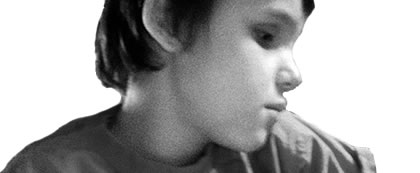
Like alexithymia, those with autism spectrum disorders (ASDs) are also known to have problems processing emotional information. This may at least partially account for some core features of autistic behaviour: especially problems in social interactions. After all, ordinary social interactions contain considerable emotional components. This post looks at studies which have examined how those with ASDs may have deficits in the automatic processing of emotions.
Hill and Frith (2003) describe three main cognitive theories of autism. Of these the one that has the clearest parallels with emotional processing theories is Baron-Cohen’s ‘mindblindness’ hypothesis. In this theory, those with ASDs are thought to have problems intuitively understanding the minds of others. But, this does not mean that individuals with autism cannot understand the mental states of others – it’s just that they have to explicitly work it out rather than the knowledge being processed implicitly.
Hill, Berthoz and Frith (2004) found problems in the cognitive processing of emotions in individuals with ASDs. They were also seen to have higher levels of depression than both a control group and a group of relations of the individuals with ASDs.
So this give us some general evidence of emotion processing problems in ASDs, but what about the dual process model of appraisal? Some exciting new evidence comes from McIntosh, Reichmann-Decker, Winkielman and Wilbargeret (2006) who examined the way adults and adolescents with ASDs mimic facial expressions.
Copying facial expressions
The mimicking of other people’s facial expression is something that we all do naturally. It oils the wheels of social interaction. We perceive the facial expression of others, then quickly and effortlessly flex corresponding muscles in our own faces to reflect the feeling back. McIntosh et al. (2006) contrast this type of automatic mimicry with the slow effortful mimicry we carry out when consciously trying to copy another’s expression.
McIntosh et al. (2006) compared the automatic responses of a control group with individuals with ASDs by using facial EMG to measure movement of the major cheek and brow muscles. There were two phases to the experiment, in the first participants simply watched a screen on which were displayed different pictures of happy and sad faces. In the second, participants were asked to copy the expression they saw in the picture.
The results showed that individuals with ASDs did not automatically mimic facial expressions they saw in the pictures, as did the control group. On the other hand, they had no problem imitating facial expression explicitly, indeed they were better at imitation than the control group. McIntosh et al. (2006) argue that this fact rules out alternative explanations of their results which include the individuals with ASDs having problems in perceiving the faces, praxis, or understanding the task they were carrying out.
Mimicry in the brain scanner
From a study carried out by Dapretto, Davies, Pfeifer, et al. (2006) we even have information about the neurological basis for these behavioural findings. In this study participants carried out a task similar to that used by McIntosh et al. (2006) but this time inside an fMRI scanner.
The major difference found in brain activation between the groups was that the individuals with ASDs showed no activation in the so-called ‘mirror neuron system’. The mirror neuron system is hypothesised to be involved in understanding the thoughts and actions of others, along with many other functions!
Again, individuals with ASDs showed no difference to the control group in imitating faces, and no differences were seen by eye tracking equipment. In other words, both groups were looking at the photos in a similar way. Those with ASDs did, however, show differences in brain activation when they attempted to imitate the face in the photo.
Dapretto et al. (2006) speculate that those with ASDs have deficits in automatic processing through the mirror neuron system, for which other parts of their brains compensate when imitating facial expressions.
ASDs and alexithymia
Both of these imitation studies provide some evidence that individuals with ASDs suffer deficits in their automatic processing of emotions, but are quite capable of imitating emotions consciously. This provides a clear parallel with the studies carried out on people with alexithymia, who also have problems with the automatic unconscious processing of emotions but can clearly describe emotions that are in focal awareness.
 References
References
Dapretto, M., Davies, M., Pfeifer, J., et al. (2006). Understanding emotions in others: mirror neuron dysfunction in children with autism spectrum disorders. Nature Neuroscience, 9(1), 28-30.
Gillberg, C., & Rastam, M. (1992). Do some cases of anorexia nervosa reflect underlying autistic conditions? Behavioural Neurology, 5, 27-32.
Hill, E., Berthoz, S., & Frith, U. (2004). Brief Report: Cognitive Processing of Own Emotions in Individuals with Autistic Spectrum Disorder and in Their Relatives. Journal of Autism and Developmental Disorders, 34(2), 229-235.
Hill, E., & Frith, U. (2003). Understanding autism: insights from mind and brain. Philosophical Transactions: Biological Sciences, 358(1430), 281-289.
McIntosh, D., Reichmann-Decker, A., Winkielman, P., Wilbargeret, J. L. (2006). When the social mirror breaks: deficits in automatic, but not voluntary, mimicry of emotional facial expressions in autism. Developmental Science, 9(3), 295-302.

